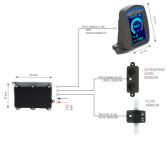The gas gauge in my 2001 Sea Ray 190BR has never worked right as long as I've owned the boat. It has always read lower than it should, never quite reaching the Full mark. I'm pretty sure the tank is full because I can't squeeze any more gas into it.
Recently, the gauge stopped working completely.
Now it hangs just above empty, regardless of how much fuel is in the tank.
I probably need a new gauge or possibly a new sending unit.
How can I determine the problem using a multimeter?
Can I buy only a gauge or just a sending unit?
Are they pretty standard? Will different brands generally work with each other?
How much trouble to install a sending unit inside the plastic fuel tank?
I'm a pretty good electronics tech and a pretty good mechanic, but not real confident digging into a fuel tank.
Recently, the gauge stopped working completely.
Now it hangs just above empty, regardless of how much fuel is in the tank.
I probably need a new gauge or possibly a new sending unit.
How can I determine the problem using a multimeter?
Can I buy only a gauge or just a sending unit?
Are they pretty standard? Will different brands generally work with each other?
How much trouble to install a sending unit inside the plastic fuel tank?
I'm a pretty good electronics tech and a pretty good mechanic, but not real confident digging into a fuel tank.


